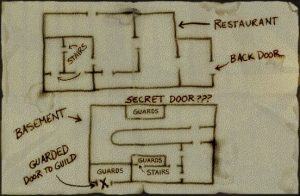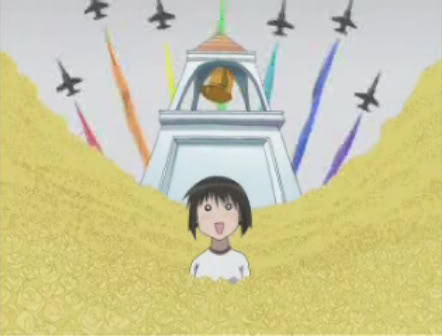Or “I hate rat quests”.
As I mentioned previously, my attempt at building a sandbox for LotFP had hit a wall and I went all the way back to square one to go on a spirit journey and find out why my campaign never turn out as I imagine them. And it really comes down to me accidentally locking all the good content that is meant to be the main feature of the setting away until the PCs have become powerful enough heroes to be able to face them. Looking back it was incredibly stupid, but… Well, there is no real but. It was stupid. It happens, and I believe it’s a pretty common mistake people make. I’ve seen it often enough and warned other people about it. Why I still did it I have no clue.
In my previous post I talked about finding what it really is that the Ancient Lands are about and what needs to be part of every adventure and dungeon in the campaign. But even with that knowledge I was still struggling with coming up with ideas for dungeons that characters at 1st to 4th level could explore without running into unbeatable and highly lethal opponents. And I think I found the solution for that as well.
I took the first step towards oldschool gaming and laid the groundwork for my current worldbuilding when I first looked into the E6 variant for Dungeons & Dragons 3rd Edition, which basically comes down to PCs and NPCs being capped at 6th level but monsters keep all their abilities. It allows you to play low powered campaigns without all the 4th to 9th level spells while still being able to play with the rules system you’re already familiar with. It got decently popular and saw great praise, but the one big question the original creator left open, somewhat on purpose, was what it means to be 6th level? Is a 6th level character a legendary one in a million hero, or is he still just as impressive as a low mid-level character in a 20 level D&D campaign and there are hundreds like him all over the place?
When I switched to B/X based rules and leaving the terrible d20 system behind, the question still remained. B/X has 14 levels instead of 6, but like OD&D and AD&D 1st Ed. it has this idea of adventuring being 1st to 9th level and the game then turning into something else. Nine levels plus a handful of legendary figures of world fame beyond that seems like a good yardstick to find the appropriate class level for NPCs based on their powers and accomplishments. But I still was thinking in the categories of low-level, mid-level, and high-level characters. And that was the source of all the problems. A low-level character is a guy with inferior equipment who goes on rat quests in noob dungeons. Whether a character reaches mid-level by 8th, 5th, or 3rd level doesn’t matter. You’re still forcing the players to begin by spending a good time doing things that are “safe” and for “ordinary people”. The whole concept of D&D is extraordinary people doing extremely lethal things, and in LotFP even more so!
Again, like so often, I blame 3rd edition for putting this stupid idea into my head and it did it with the idea of NPC classes. NPC classes are similar to ordinary character classes but are weaker and have fewer abilities, but they still let NPCs go from 1st to 20th level. And that’s just stupid. It’s not just the 20th level commoner that is stupid. Even the 5th level expert or the 7th level adept are stupid. Why do you need a carpenter that has more hit points and fights as well as a 4th level fighter? Why is that powerful orc spellcaster not a sorcerer or a cleric? Even just the harmless looking 2nd level warrior town guard or 3rd level expert blacksmith fly in the face of the idea that PCs are extraordinary people. 6th level PCs are noteworth people and 1st level PCs are noobs who barely can keep up with the plot relevant civilians.
That’s bullshit and I established quite some time ago the paradigm that in the Ancient Lands any NPC without a proper name is automatically a level 0 character. NPCs who are not noteworth warriors or spellcasters are also 0 level and have 1d6 hp and +0 to attack. But even with that I still had that meme in my brain that proper adventures start only once the players have fought their way up to mid-levels. (Basically the content of the first scene in Inception.)
Understanding how I went all wrong very quickly solved my problem with not having any content that can appropriately scaled to 1st level parties. I am just taking a lot of content that I had planned to be suitable for 4th or 6th level parties and adjust the monsters so 1st level parties won’t be instant-splatted. And when you’re playing in a B/X context that’s actually not that hard. Most pretty big monsters are not that well protected and often meant to be encountered in groups of sometimes considerable size. I am still very much in love with the idea of the Nameless Dungeon and to adapt it to the Ancient Lands it will be inhabited by shie, a custom fey creature with 4 Hit Dice. My logi went: 4 HD is meant for 4th dungeon level, whicb is meant for 4th level parties, so if the dungeon is full with them the party should be at least 5th level before getting anywhere near it. But that’s actually not needed. A dungeon build around the shie does not have to have lots of rooms with groups of shie in them. It can still be about them if the players only rarely run into one or two individuals. Or take for example the famous Steading of the Hill Giant Chief: To have an adventure about hill giants you don’t need a party that is able to fight 20 hill giants at once. The most famous giant story is Odysseus and his men in the cave of th cyclops. Only one giant that had the heroes outmatched all by himself. Foreshadowing that the master of the cave is a giant can make exploring a cave full of goblins and giant rats still a giant adventure.
No more “Mr. Kimble I don’t like this Noob Dungeon…” There is no Noob-Dungeon!


